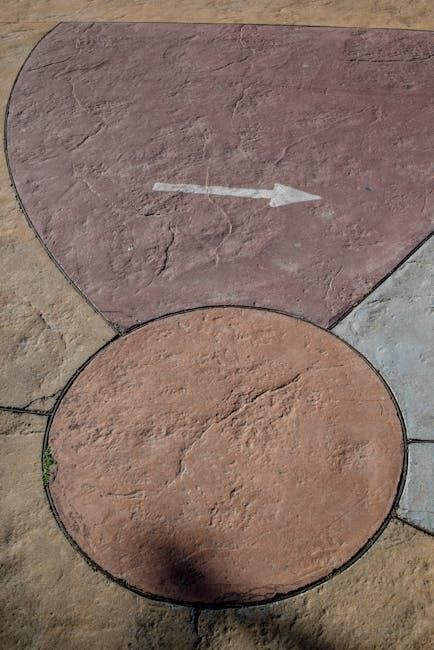What is a Linear Guide Rail System?
A linear guide rail system is a mechanical assembly designed to facilitate smooth, precise linear motion. It consists of a rail and a carriage that moves along it, supporting loads and providing guidance. These systems are crucial in various applications requiring accurate movement.
Basic Definition and Function
A linear guide rail system, at its core, is a mechanism that enables controlled linear movement of components; It comprises a rail, which serves as the pathway, and a carriage, also known as a slider or block, that travels along this rail. The primary function of these systems is to provide support and guidance for moving loads in a straight line with minimal friction and high precision. This ensures that the moving parts do not deviate from the intended path, maintaining accuracy and stability. Linear guide rails are designed to support and evenly align carriage systems, providing a stable platform for various industrial and automation applications. They ensure that the motion is smooth and efficient, reducing the amount of power needed for movement, which enhances overall performance. The linear guidance systems are designed with accuracy and reliability in mind, making them a fundamental part of many mechanical systems.
Key Components⁚ Rail, Carriage, and Rolling Elements
A linear guide rail system is built upon three essential components⁚ the rail, the carriage, and the rolling elements. The rail, typically made of hardened steel, provides the precise track along which the carriage moves. The carriage, or block, is the moving component that carries the load and is designed to interface with the rail. Between the rail and the carriage are the rolling elements, which are typically either balls or rollers. These elements facilitate smooth, low-friction movement by recirculating within the carriage as it travels along the rail. The design of the rolling elements is crucial in determining the load capacity and precision of the system. The interaction between these three components is what enables the efficient and accurate linear motion, making them the core of the linear guide rail system. Each element works in harmony to ensure smooth, reliable operation.
How Linear Guide Systems Work
Linear guide systems function by utilizing recirculating rolling elements between a rail and carriage. This design enables smooth, low-friction movement, allowing precise linear motion and efficient load handling along the guide.
The Mechanism of Linear Motion
The mechanism of linear motion in these systems is primarily achieved through the interaction of several key components. A carriage, also known as a slider or block, moves along a precisely manufactured rail. This movement is facilitated by rolling elements, often ball or roller bearings, that recirculate within the carriage. The bearings roll between the rail and the carriage, minimizing friction and allowing for smooth, controlled linear travel. The design ensures that the carriage is guided along a straight path, enabling accurate and repeatable positioning. This precise movement is essential for applications requiring high levels of accuracy and stability. This system uses curved grooves that provide surface contact between the balls and rails, making the permissible load far greater. The system is composed of the linear rail, the rolling elements, and the carriage. The linear motion is enabled by a mechanism for recirculating the balls.
Recirculating Ball Bearings and Load Handling
Recirculating ball bearings are a crucial element in linear guide rail systems, enabling them to handle substantial loads while maintaining smooth movement. These bearings are contained within the carriage and move in a closed loop, rolling between the rail and the carriage, and then recirculating back to the start. This recirculating action allows for continuous linear motion with minimal friction. The design distributes the load evenly across multiple ball bearings, enhancing the system’s load-carrying capacity. These systems are designed with curved grooves that provide surface contact between the balls and rails, making the permissible load far greater than guide components that use only single-point contact, such as linear rods. The recirculating ball bearings allow for extremely heavy loads to be moved efficiently. This mechanism ensures that the system can withstand significant weight and operate with precision, contributing to its overall performance and reliability.

Advantages of Linear Guide Rail Systems
Linear guide rail systems offer several benefits, including low friction, high efficiency, and precision movement. They enable smooth, accurate motion and can handle heavy loads, making them ideal for various applications.
Low Friction and High Efficiency
Linear guide rail systems are engineered to minimize friction, which is a key advantage. Unlike traditional sliding bearings, these systems utilize rolling elements such as balls or rollers, significantly reducing the contact surface and thus the frictional resistance. This low friction characteristic translates to higher efficiency, meaning that less power is required to move a load. This, in turn, allows for the achievement of higher speeds and reduces energy consumption, making linear guide rail systems a more cost-effective and environmentally friendly solution for linear motion applications. The reduced friction also leads to less wear and tear on the components, contributing to a longer lifespan of the system and reduced maintenance requirements. The smooth movement enabled by low friction ensures a consistent and reliable operation.
Precision and Smooth Movement
Linear guide rail systems offer exceptional precision and smooth movement, which are vital for many industrial applications. The precision-engineered rails and carriages ensure that the moving components follow a defined path with minimal deviation. This accuracy is achieved through tight tolerances and the use of high-quality materials. The rolling elements, such as recirculating ball bearings, provide a smooth and consistent motion, eliminating jerky or uneven movement. The combined effect of precision and smooth motion results in highly reliable and repeatable performance. This is particularly important in applications like CNC machining and robotics where accuracy and consistency are paramount. The ability of linear guides to maintain precision over extended periods of use makes them a cornerstone in modern manufacturing and automation.

Applications of Linear Guide Rail Systems
Linear guide rail systems are extensively used across various industries. They enable precise and controlled movement in machinery, robotics, and automation equipment, facilitating efficient manufacturing processes and complex operations.
Industrial Automation and Robotics
In industrial automation and robotics, linear guide rail systems are indispensable for achieving precise and reliable motion. These systems facilitate the movement of robotic arms and automated machinery, enabling tasks such as pick-and-place operations, assembly line movements, and material handling with high accuracy and efficiency. The low friction and high load capacity of linear guides contribute to the smooth and reliable operation of automated systems, minimizing downtime and enhancing productivity. They are used in various applications, including robotic welding, automated assembly, and packaging processes. The precision offered by these systems ensures consistent and accurate performance, crucial for maintaining quality and efficiency in automated manufacturing environments. Furthermore, linear guides’ durability and long lifespan make them suitable for demanding industrial applications, supporting continuous operation in diverse automated systems. Their ability to handle heavy loads with minimal wear also makes them ideal for robotic applications requiring robust and reliable performance.
CNC Machines and Manufacturing
Linear guide rail systems are a cornerstone in CNC machines and manufacturing processes, providing the accurate and stable movement necessary for precise cutting, shaping, and milling. These systems enable the smooth and controlled motion of cutting tools and workpieces, ensuring high-quality outputs with tight tolerances. In CNC machines, linear guides support the movement of the axes, allowing for intricate and complex designs to be realized accurately. The low friction and high precision of these systems are critical for achieving the required surface finishes and dimensional accuracies in manufactured parts. The robust nature of linear guide rails also ensures the stability and reliability of CNC machines under heavy loads and prolonged operation, contributing to their long-term performance and efficiency. They are fundamental to various manufacturing processes like turning, drilling, and grinding, enhancing the overall precision and productivity of manufacturing operations. Their high load capacities and smooth motion ensure that these processes are conducted accurately and efficiently, leading to high-quality output and reduced waste.

Types of Linear Guide Rail Systems
Linear guide rail systems come in various types, including ball bearing guides and roller bearing guides. These differ in their rolling elements, affecting load capacity, speed, and precision.
Ball Bearing Guides
Ball bearing guides are a common type of linear guide system, utilizing recirculating ball bearings to facilitate movement. These guides are known for their low friction, allowing for smooth and efficient motion along the rail. The design typically involves hardened raceways, which provide a durable surface for the balls to roll on. This results in reduced wear and extends the lifespan of the guide system. Ball bearing guides are particularly suitable for applications requiring high precision and consistent performance. The rolling motion of the balls minimizes resistance, enabling faster speeds and greater efficiency in transferring loads. They are a reliable choice for many industrial automation and precision machinery applications. The recirculating design allows for continuous motion without the need for frequent lubrication or maintenance, making them a practical solution for many diverse needs.
Roller Bearing Guides
Roller bearing guides are another type of linear guide system that use cylindrical rollers instead of balls for motion. These guides offer a larger contact area, allowing them to handle heavier loads compared to ball bearing guides. The rollers are typically made of hardened steel, ensuring durability and resistance to wear. This larger contact area also provides increased stiffness and stability, making them ideal for applications with high force requirements. Roller bearing guides are often used in heavy machinery and industrial automation where high load capacity and structural integrity are critical. They are designed to distribute load across the roller surface, minimizing stress and deformation. While roller guides might have a slightly higher friction coefficient than ball guides, their load-bearing capabilities and robustness make them a preferred option for specific applications requiring the transport of heavy and bulky items with precision and consistency.

Installation and Mounting
Linear guide rail systems require secure installation using various fastening elements, including clamping fixtures, sliding blocks, and screws. Proper mounting ensures stability and accurate performance of the system, integrating it with other components.
Fastening Elements and Methods
Securing linear guide rails effectively involves a range of fastening elements and methods, each tailored to specific application needs. Clamping fixtures provide a robust and adjustable means of attachment, often used for securing the rails to a base structure. Sliding blocks, particularly suitable for larger systems, allow for easy adjustment and alignment. Square nuts and spring nuts are commonly employed to fasten components together, ensuring a tight and reliable connection. Screws are essential for joining various parts, like the carriage to the rail or the rail to the mounting surface. Proper tightening torque is critical to maintain stability and prevent loosening during operation. Fastening profiles, often used in conjunction with screws, offer a simple way to join linear guide systems without machining. These methods collectively ensure the accurate and secure installation of linear guide systems, enabling precise and reliable linear motion in a variety of applications.
Integration with Linear Motor Systems
Integrating linear guide rail systems with linear motor systems creates a powerful combination for high-precision motion control. Linear motors provide direct thrust, eliminating the need for traditional mechanical transmission elements like screws or belts. This direct drive approach leads to faster acceleration, higher speeds, and improved accuracy. The linear guide rail system is crucial for supporting the load and ensuring smooth, precise movement as the motor drives the carriage along the rail. The integration often involves direct mounting of the linear motor components onto the carriage. Careful alignment between the motor and guide rail is essential for optimal performance and to minimize wear. The result is a seamless and efficient motion system suitable for demanding applications. An integrated system ensures precise positioning, smooth motion, and low maintenance needs.




